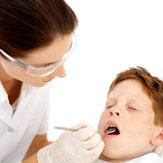 SUV Dental Service
SUV Dental Service
Pediatric Dentistry (Pedodontics) is a dental science focusing on the treatment of children. This specialized care helps children feel comfortable with dentistry; restores and maintains primary and permanent dentitions; assists in the prevention of dental caries and periodontal disease; and corrects difficulties of occlusion.
Pediatric Dentistry includes:
- Behavior management and dental education
– Monitoring of the dental eruption
– Routine dental check-up
– Child dietary consultation
– Fluoride application treatment
– Cleaning & polishing
– Restorations and tooth-colour filling of deciduous teeth
– Sealant of the permanent teeth
– Space maintainer, space regainer
– Root canal treatment and stainless steel crown of the deciduous teeth
Frequently Asked Questions from Pediatric Dentists
Infant Dental Care
Q: How do you clean a baby’s teeth?
A: Plaque bacteria can be removed with a toothbrush. A soft-bristled toothbrush with a small head, preferably one designed for infants, should be used three times a day.
Q: Are baby teeth really that important to my child?
A: Baby teeth serve many purposes. They allow a child to speak properly and to chew. They also provide the framework for the permanent dentition.
Q: Can I prevent baby bottle tooth decay?
A: Yes, there are several practices that will help prevent the type of tooth decay termed “baby bottle tooth decay.” Since this type of decay is usually caused by the frequent and long-term exposure of a child’s teeth to liquids containing sugars, measures can be taken avoid these extended exposures.
- Never allow children to fall asleep with a bottle in their mouth that contains milk, formula, juice or other sugar-based liquids
- To help establish healthy teeth and aid in teething, you can clean and massage your baby’s gums.
- Upon the eruption of the first baby tooth, you should begin plaque removal techniques, brushing your child’s teeth using a soft toothbrush.
- Your baby’s first visit to the dentist should be between the age of six and 12 months.
Dental Care for young children
Q: When should we being using toothpaste and how much we should use?
A: When a child 2-3 years of age fluoridated toothpaste should be introduced. Before this time, parents should clean the child’s teeth with water and a soft-bristled toothbrush. After the age of 2-3, parents should supervise brushing and make sure the child uses no more than a pea-sized amount on the brush. Children should not swallow excess toothpaste after brushing.
Q: Is my child getting enough fluoride?
A: Your pediatric dentist may prescribe fluoride supplements if your child is not getting enough through drinking water. If your child primarily drinks bottled water without fluoride this may be necessary. Ask your pediatric dentist for an evaluation if you are concerned.
Q: How often does my child need to see the pediatric dentist?
A: In order prevent cavities and other dental problems a check-up is recommended every six months. Your pediatric dentist can tell you when and how often your children should visit based on their personal oral health.
Q: How can I protect my child’s teeth during sports?
A: Plastic mouthguards can be used to protect a child’s teeth from sport related injuries. A custom mouthguard developed by a pediatric dentist will protect your child from injuries to the teeth, face and even provide protection from severe head injuries by providing a small cushion for shock absorbing.
Q: How can I help my child remain cavity-free?
A: The American Academy of Pediatric Dentistry advises that your child should brush with fluoride toothpaste twice a day. They also suggest that you floss your children’s teeth once a day until they are able to do it themselves – around the age of 10.
They recommend that your child get enough fluoride and have sealants applied to the chewing surface of permanent back teeth or molars soon after they come in. In addition, they suggest moderate snacking – only twice per day.
Q: What are dental sealants?
A: Dental sealants protect the chewing surfaces of back teeth where cavities occur most often for children. Sealants, composed of clear or shaded plastic, are painted onto the tiny grooves in the molars.
By “sealing out” food and plaque, sealants reduce the risk of tooth decay. Sealants can be quickly and painlessly applied to any permanent teeth that are likely to develop decay on the biting surface.
